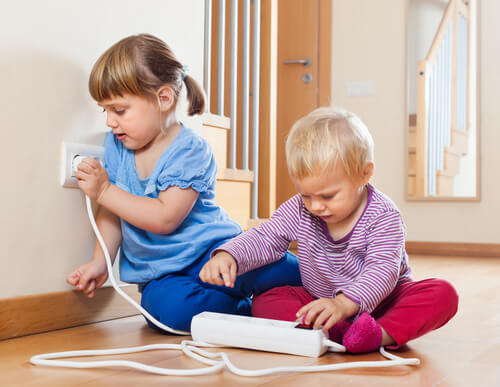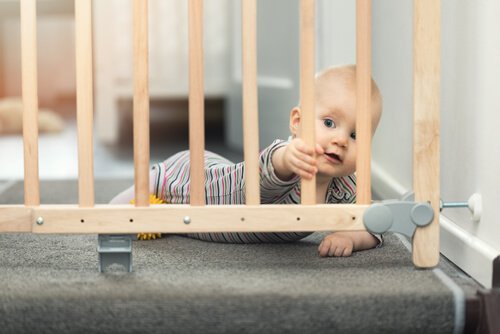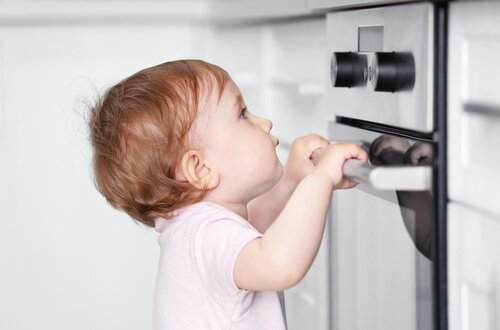Babyproof Your Home: What You Need to Know

By learning how to babyproof your home, you’ll feel a lot more at ease once your little one starts gaining more independence.
When babies start to crawl or, a few months later, take their first steps, their homes become fascinating places to explore. Everything grabs their attention, and safety isn’t their priority. Wall sockets, remote controls, drawers, and even the toilet will pique your baby’s curiosity.
Read this article to learn how to babyproof your home effectively.
Greater safety for greater independence
As your child grows, we recommend following preventative measures. By learning how to babyproof your home, you’ll make his or her little world a safe place.
1. Wall sockets and corners need to be covered. You need to cover up sharp furniture corners, and put protective plugs in all electrical sockets. Grounded sockets are safer. In any case, these must also be covered with plugs.

2. Take care of your cables. Avoid having any object with a cable within your baby’s reach, including baby monitors and telephones. Keep in mind that any object that requires cables should be considered dangerous.
3. Affix heavy or large objects for safety. When your baby begins to crawl, he or she will lean on everything within reach. For this reason, you need to ensure that bookcases, TVs, furniture, and other objects in your home are affixed to the ground or wall.
Children need to explore their surroundings, but you need to make sure they do so safely by following some essential measures.
More safety recommendations
In addition to securing household objects, you need to address the house’s entrances and exits.
1. Prevent access to any potentially dangerous areas. Garages, basements, bathrooms, kitchens, and exercise rooms are all areas that could be dangerous to your baby. Any furniture containing cleaning products, paint, heavy tools, or chemical products should be locked with a key.
2. Teach your child to walk safely. When your baby is ready to take his or her first steps, make sure to help him or her practice going up and down stairs, showing how to hold onto the railing. Remove any small rugs that may lead to slips or falls.
3. Babyproof the stairs. If you have stairs in your home, place baby gates at the top and bottom. If the stairs are accessed through a door, make sure that your child learns to open it as he or she gets older. We recommend putting a lock on any such door.

Tips to babyproof your home effectively
- Eliminate access to windows. Don’t place any chairs or furniture near windows that make it easier for your child to get near them. If necessary, install some simple mechanisms that prevent your child from opening them. On balconies, the railing should be high and the distance between the bars should be small.
- Keep sewing kits and toolboxes out of your child’s reach.
- Be extremely careful with plastic bags. Small children can asphyxiate by putting their heads inside them.
- Don’t leave batteries, lighters, or matches lying around. Also keep small objects such as coins and buttons out of reach so that your child doesn’t swallow them.
- Medication and medicine should be kept out of reach, or locked away in closets.
- Don’t take medication or medicine in front of your child. This is because children have a tendency to imitate what adults do. In the event that the child needs to take medicine, don’t convince them that it’s candy so that they take it.
- Don’t leave your child alone when the stove or oven is on. It’s preferable that your oven is in a high place. If this isn’t possible, try to keep your child away from it when it’s on.

- Place anti-slip strips under rugs. This will prevent your child from slipping and falling when running around the house.
- Make sure that the child’s toys are age-appropriate and don’t contain small pieces that present a choking hazard.
Remember that it’s important to babyproof your home not only to benefit your child, but also to considerably reduce the risk of household accidents for the entire family.
By learning how to babyproof your home, you’ll feel a lot more at ease once your little one starts gaining more independence.
When babies start to crawl or, a few months later, take their first steps, their homes become fascinating places to explore. Everything grabs their attention, and safety isn’t their priority. Wall sockets, remote controls, drawers, and even the toilet will pique your baby’s curiosity.
Read this article to learn how to babyproof your home effectively.
Greater safety for greater independence
As your child grows, we recommend following preventative measures. By learning how to babyproof your home, you’ll make his or her little world a safe place.
1. Wall sockets and corners need to be covered. You need to cover up sharp furniture corners, and put protective plugs in all electrical sockets. Grounded sockets are safer. In any case, these must also be covered with plugs.

2. Take care of your cables. Avoid having any object with a cable within your baby’s reach, including baby monitors and telephones. Keep in mind that any object that requires cables should be considered dangerous.
3. Affix heavy or large objects for safety. When your baby begins to crawl, he or she will lean on everything within reach. For this reason, you need to ensure that bookcases, TVs, furniture, and other objects in your home are affixed to the ground or wall.
Children need to explore their surroundings, but you need to make sure they do so safely by following some essential measures.
More safety recommendations
In addition to securing household objects, you need to address the house’s entrances and exits.
1. Prevent access to any potentially dangerous areas. Garages, basements, bathrooms, kitchens, and exercise rooms are all areas that could be dangerous to your baby. Any furniture containing cleaning products, paint, heavy tools, or chemical products should be locked with a key.
2. Teach your child to walk safely. When your baby is ready to take his or her first steps, make sure to help him or her practice going up and down stairs, showing how to hold onto the railing. Remove any small rugs that may lead to slips or falls.
3. Babyproof the stairs. If you have stairs in your home, place baby gates at the top and bottom. If the stairs are accessed through a door, make sure that your child learns to open it as he or she gets older. We recommend putting a lock on any such door.

Tips to babyproof your home effectively
- Eliminate access to windows. Don’t place any chairs or furniture near windows that make it easier for your child to get near them. If necessary, install some simple mechanisms that prevent your child from opening them. On balconies, the railing should be high and the distance between the bars should be small.
- Keep sewing kits and toolboxes out of your child’s reach.
- Be extremely careful with plastic bags. Small children can asphyxiate by putting their heads inside them.
- Don’t leave batteries, lighters, or matches lying around. Also keep small objects such as coins and buttons out of reach so that your child doesn’t swallow them.
- Medication and medicine should be kept out of reach, or locked away in closets.
- Don’t take medication or medicine in front of your child. This is because children have a tendency to imitate what adults do. In the event that the child needs to take medicine, don’t convince them that it’s candy so that they take it.
- Don’t leave your child alone when the stove or oven is on. It’s preferable that your oven is in a high place. If this isn’t possible, try to keep your child away from it when it’s on.

- Place anti-slip strips under rugs. This will prevent your child from slipping and falling when running around the house.
- Make sure that the child’s toys are age-appropriate and don’t contain small pieces that present a choking hazard.
Remember that it’s important to babyproof your home not only to benefit your child, but also to considerably reduce the risk of household accidents for the entire family.
This text is provided for informational purposes only and does not replace consultation with a professional. If in doubt, consult your specialist.








